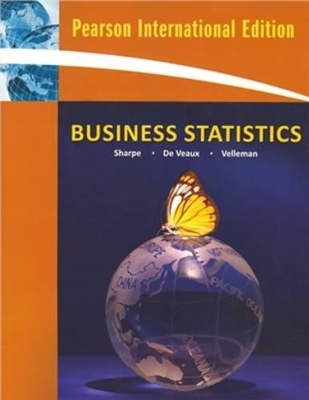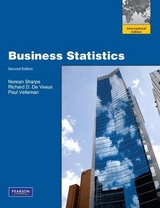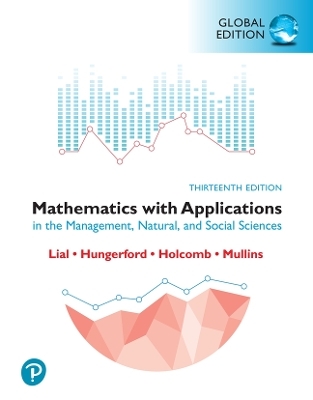
Business Statistics
Pearson
978-0-321-61597-8 (ISBN)
- Titel erscheint in neuer Auflage
- Artikel merken
Managers make better business decisions when they understand statistics, and Business Statistics gives students the statistical tools and understanding to take them from the classroom to the boardroom. Hundreds of examples are based on current events and timely business topics. Short, accessible chapters allow for flexible coverage of important topics, while the conversational writing style maintains student interest and improves understanding.
Business Statistics includes Guided Examples that feature the authors’ signature Plan/Do/Report problem-solving method. Each worked example shows students how to clearly define the business decision to be made and plan which method to use, do the calculations and make the graphical displays, and finally report their findings, often in the form of a business memo. Every chapter reminds students of What Can Go Wrong and teaches them how to avoid making common statistical mistakes.
Norean Sharpe (Ph.D. University of Virginia), as a researcher of statistical problems in business and a professor at a business school, understands the challenges and specific needs of the business student. She is currently Professor of Statistics at Babson College, where she is also Chair of the Division of Mathematics and Science. She is the recipient of the 2008 Women Who Make a Difference Award for female faculty at Babson. Prior to joining Babson, she taught statistics and applied mathematics courses for several years at Bowdoin College. Norean is coauthor of the recent text, A Casebook for Business Statistics: Laboratories for Decision Making, and has authored over 30 articles-primarily in the areas of statistics education and women in science. Norean currently serves as Associate Editor for CAUSE (Consortium for the Advancement of Undergraduate Statistics Education) and Associate Editor for the journal Cases in Business, Industry, and Government Statistics. Her research focuses on business forecasting and statistics education. Richard D. De Veaux (Ph.D. Stanford University) is an internationally known educator, consultant, and lecturer. Dick has taught Statistics at a business school (The Wharton School of the University of Pennsylvania), an engineering school (Princeton University) and a liberal arts college (Williams College). He is an internationally known lecturer in data mining and is a consultant for many Fortune 500 companies in a wide variety of industries. While at Princeton, he won a Lifetime Award for Dedication and Excellence in Teaching. Since 1994, he has been a Professor of Statistics at Williams College. Dick holds degrees from Princeton University in Civil Engineering and Mathematics, and from Stanford University in Dance Education and Statistics, where he studied with Persi Diaconis. His research focuses on the analysis of large data sets and data mining in science and industry. Dick has won both the Wilcoxon and Shewell awards from the American Society for Quality and is a Fellow of the American Statistical Association. Dick is well known in industry, having consulted for such companies as American Express, Hewlett-Packard, Alcoa, DuPont, Pillsbury, General Electric, and Chemical Bank. He was named the “Statistician of the Year” for 2008 by the Boston Chapter of the American Statistical Association for his contributions to teaching, research, and consulting. In his spare time he is an avid cyclist and swimmer. He also is the founder and bass for the Doo-wop group, “Diminished Faculty,” and is a frequent soloist with various local choirs and orchestras. Dick is the father of four children. Paul F. Velleman (Ph.D. Princeton University) has an international reputation for innovative statistics education. He designed the Data Desk® software package and is also the author and designer of the award-winning ActivStats® statistics package, for which he received the EDUCOM Medal for innovative uses of computers in teaching statistics and the ICTCM Award for Innovation in Using Technology in College Mathematics. He is the founder and CEO of Data Description, Inc. (www.datadesk.com), which supports both of these programs. He also developed the Internet site, Data and Story Library (DASL) (dasl.datadesk.com), which provides data sets for teaching Statistics. Paul co-authored (with David Hoaglin) the book ABCs of Exploratory Data Analysis. Paul has taught Statistics at Cornell University on the faculty of the School of Industrial and Labor Relations since 1975. His research often focuses on statistical graphics and data analysis methods. Paul is a Fellow of the American Statistical Association and of the American Association for the Advancement of Science. Paul’s experience as a professor, entrepreneur and business leader brings a unique perspective to the book. Dick De Veaux and Paul Velleman have authored successful books in the introductory college and AP High School market with Dave Bock, including Intro Stats, Third Edition (Pearson, 2009), Stats: Modeling the World, Third Edition (Pearson, 2010), and Stats: Data and Models, Second Edition (Pearson, 2008).
PART I: EXPLORING AND COLLECTING DATA
1. Statistics and Variation
2. Data
2.1 What Are Data?
2.2 Variable Types
2.3 Where, How, and When
3. Surveys and Sampling
3.1 Three Ideas of Sampling
3.2 A Census–Does it Make Sense?
3.3 Populations and Parameters
3.4 Simple Random Sample (SRS)
3.5 Other Sample Designs
3.6 Defining the Population
3.7 The Valid Survey
4. Displaying and Describing Categorical Data
4.1 The Three Rules of Data Analysis
4.2 Frequency Tables
4.3 Charts
4.4 Contingency Tables
5. Randomness and Probability
5.1 Random Phenomena and Probability
5.2 The Non-existent Law of Averages
5.3 Different Types of Probability
5.4 Probability Rules
5.5 Joint Probability and Contingency Tables
5.6 Conditional Probability
5.7 Constructing Contingency Tables
6. Displaying and Describing Quantitative Data
6.1 Displaying Distributions
6.2 Shape
6.3 Center
6.4 Spread of the Distribution
6.5 Shape, Center, and Spread–A Summary
6.6 Five-Number Summary and Boxplots
6.7 Comparing Groups
6.8 Identifying Outliers
6.9 Standardizing
6.10 Time Series Plots
*6.11 Transforming Skewed Data
PART II: UNDERSTANDING DATA AND DISTRIBUTIONS
7. Scatterplots, Association, and Correlation
7.1 Looking at Scatterplots
7.2 Assigning Roles to Variables in Scatterplots
7.3 Understanding Correlation
*7.4 Straightening Scatterplots
7.5 Lurking Variables and Causation
8. Linear Regression
8.1 The Linear Model
8.2 Correlation and the Line
8.3 Regression to the Mean
8.4 Checking the Model
8.5 Learning More from the Residuals
8.6 Variation in the Model and R2
8.7 Reality Check: Is the Regression Reasonable?
9. Sampling Distributions and the Normal Model
9.1 Modeling the Distribution of Sample Proportions
9.2 Simulation
9.3 The Normal Distribution
9.4 Practice with Normal Distribution Calculations
9.5 The Sampling Distribution for Proportions
9.6 Assumptions and Conditions
9.7 The Central Limit Theorem–The Fundamental Theorem of Statistics
9.8 The Sampling Distribution of the Mean
9.9 Sample Size–Diminishing Returns
9.10 How Sampling Distribution Models Work
10. Confidence Intervals for Proportions
10.1 A Confidence Interval
10.2 Margin of Error: Certainty vs. Precision
10.3 Critical Values
10.4 Assumptions and Conditions
*10.5 A Confidence Interval for Small Samples
10.6 Choosing Sample Size
11. Testing Hypotheses about Proportions
11.1 Hypotheses
11.2 A Trial as a Hypothesis Test
11.3 P-values
11.4 The Reasoning of Hypothesis Testing
11.5 Alternative Hypotheses
11.6 Alpha Levels and Significance
11.7 Critical Values
11.8 Confidence Intervals and Hypothesis Tests
11.9 Two Types of Errors
*11.10 Power
12. Confidence Intervals and Hypothesis Tests for Means
12.1 The Sampling Distribution for the Mean
12.2 A Confidence Interval for Means
12.3 Assumptions and Conditions
12.4 Cautions About Interpreting Confidence Intervals
12.5 One-Sample t-Test
12.6 Sample Size
12.7 Degrees of Freedom–Why (n-1)?
13. Comparing Two Means
13.1 Testing Differences Between Two Means
13.2 The Two-Sample t-test
13.3 Assumptions and Conditions
*13.4 A Confidence Interval for the Difference Between Two Means
13.5 The Pooled t-test
*13.6 Tukey’s Quick Test
14. Paired Samples and Blocks
14.1 Paired Data
14.2 Assumptions and Conditions
14.3 The Paired t-Test
14.4 How the Paired t-Test Works
15. Inference for Counts: Chi-Square Tests
15.1 Goodness of Fit Tests
15.2 Interpreting Chi-square Values
15.3 Examining the Residuals
15.4 The Chi-Square Test of Homogeneity
15.5 Comparing Two Proportions
15.6 Chi-Square Test of Independence
PART III: EXPLORING RELATIONSHIPS AMONG VARIABLES
16. Inference for Regression
16.1 The Population and the Sample
16.2 Assumptions and Conditions
16.3 The Standard Error of the Slope
16.4 A Test for the Regression Slope
16.5 A Hypothesis Test for Correlation
16.6 Standard Errors for Predicted Values
16.7 Using Confidence and Prediction Intervals
17. Understanding Residuals
17.1 Examining Residuals for Groups
17.2 Extrapolation and Prediction
17.3 Unusual and Extraordinary Observations
17.4 Working with Summary Values
17.5 Autocorrelation
17.6 Linearity
17.7 Transforming (Re-expressing) Data
17.8 The Ladder of Powers
18. Multiple Regression
18.1 The Multiple Regression Model
18.2 Interpreting Multiple Regression Coefficients
18.3 Assumptions and Conditions for the Multiple Regression Model
18.4 Testing the Multiple Regression Model
*18.5 Adjusted R2, and the Multiple Regression F-statistic
*18.6 The Logistic Regression Model
19. Building Multiple Regression Models
19.1 Indicator (or Dummy) Variables
19.2 Adjusting for Different Slopes — Interaction Terms
19.3 Multiple Regression Diagnostics
19.4 Building Regression Models
19.5 Colinearity
19.6 Quadratic Terms
20. Time Series Analysis
20.1 What is a Time-Series?
20.2 Components of a Time Series
20.3 Smoothing Methods
20.4 Simple Moving Average Methods
20.5 Weighted Moving Averages
20.6 Exponential Smoothing Methods
20.7 Summarizing Forecast Error
20.8 Autoregressive Models
20.9 Random Walks
20.10 Multiple Regression-based Models
20.11 Additive and Multiplicative Models
20.12 Cyclical and Irregular Components
20.13 Forecasting with Regression-based Models
20.14 Choosing a Time Series Forecasting Method
20.15 Interpreting Time Series Models: The Whole Food Data Revisited
PART IV: BUILDING MODELS FOR DECISION MAKING
21. Probability Models
21.1 Expected Value of a Random Variable
21.2 Standard Deviation of a Random Variable
21.3 Properties of Expected Values and Variances
21.4 Discrete Probability Methods
21.5 Continuous Random Variables
22. Decision Making and Risk
22.1 Actions, Stats of Nature, and Outcomes
22.2 Payoff Tables and Decision Trees
22.3 Minimizing Loss and Maximizing Gain
22.4 The Expected Value of an Action
22.5 Expected Value with Perfect Information
22.6 Decisions Made with Sample Information
22.7 Estimating Variation
22.8 Sensitivity
22.9 Simulation
22.10 Probability Trees
* 22.11 Reversing the Conditioning: Babyes's Rule
22.12 More Complex Decisions
23. Design and Analysis of Experiments and Observational Studies
23.1 Observational Studies
23.2 Randomized, Comparative Experiments
23.3 The Four Principles of Experimental Design
23.4 Experimental Designs
23.5 Blinding and Placebos
23.6 Confounding and Lurking Variables
23.7 Analyzing a Design in One Factor - The Analysis of Variance
23.8 Assumptions and Conditions for ANOVA
*23.9 Multiple Comparisons
23.10 Analysis of Multi Factor Designs
24. Introduction to Data Mining
24.1 Direct Marketing
24.2 Data
24.3 The Goals of Data Mining
24.4 Data Mining Myths
24.5 Successful Data Mining
24.6 Data Mining Problems
24.7 Data Mining Algorithms
24.8 The Data Mining Process
24.9 Summary
*Indicates an optional topic
| Erscheint lt. Verlag | 28.2.2009 |
|---|---|
| Sprache | englisch |
| Maße | 216 x 276 mm |
| Themenwelt | Mathematik / Informatik ► Mathematik ► Finanz- / Wirtschaftsmathematik |
| ISBN-10 | 0-321-61597-2 / 0321615972 |
| ISBN-13 | 978-0-321-61597-8 / 9780321615978 |
| Zustand | Neuware |
| Haben Sie eine Frage zum Produkt? |
aus dem Bereich



